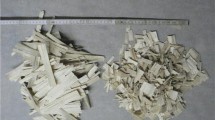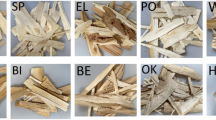Abstract
Five sets of three-layer OSB were made from aspen and/or Moso bamboo strands in the following three configurations: Aspen strands in the surface and core layers; Moso strands in the surface and core layers; and Moso strands in the surface and aspen strands in the core. Boards containing Moso strands in the surface layers had two sub groups: (1) all strands contain a node in the middle, and (2) all strands are node free (internode). All 30 boards were comprised of 50 % w/w surface furnish and 50 % core furnish, fabricated to 737 mm × 737 mm × 11.1 mm. Standard mechanical (thickness, density, surface and core density) and strength properties [internal bond (IB), flexure, lateral nail withdrawal resistance (LNR)], and water resistance [2 and 24 h thickness swell (TS) and water absorption (WA)] were assessed. Complete replacement of the aspen in the surface layers with internode Moso strands resulted in over 45 % greater MOR. Panels made with Moso surface layers met CSA O437.0 (2011) minimum requirements TS/WA without the need for wax addition, possibly because no densification of the surface material was observed. Due to high variance in LNR, effects of board type and core composition were not statistically significant, but LNR of boards exceeded CSA O437.0 minimum requirements. Moso bamboo surface OSB were low in MOE which is consistent with unadulterated tissue being high in bending strength and fracture toughness but low in specific stiffness. The presence of nodes in the bamboo strands significantly reduced the strength properties of OSB, a problem which could be mitigated by minimising the incidence of nodes in the strands, particularly those used in the surface layers.







Similar content being viewed by others
References
Amino Y (2003) Conception and feasibility of bamboo-precocious wood composite beams. J Bamboo Rattan 2(3):261–279
Andrews CK (1998) The influence of furnish moisture content and press closure rate on the formation of the vertical density profile in oriented strand board: relating the vertical density profile to bending properties, dimensional stability and bond performance. MSc Thesis, The University of Tennessee, Knoxville
Andrews CK, Winistorfer PM, Bennett RM (2001) The influence of furnish moisture content and press closure rate on the formation of the vertical density profile of oriented strand board. Forest Prod J 51(5):32–39
Andtbacka S (2005) A fibreline designed for bamboo pulping. TAPPSA Journal November 2005, 13 pp. http://www.tappsa.co.za/archive2/Journal_papers/Bamboo_pulping/bamboo_pulping.html, Accessed 5 July 2014
ASTM (2006) Standard test method for evaluating properties of wood-base fiber and particle panel materials-D 1037-06a. American Society for Testing and Materials International, West Conshohocken, p 30
Barnes D (2002) A model of the effect of fines content on the strength properties of oriented strand wood composites. For Prod J 52(5):55–60
Blomberg J, Persson B, Bexell U (2006) Effects of semi-isotropic densification on anatomy and cell shape recovery on soaking. Holzforschung 60(3):322–331
Cai Z, Winandy JE (2005) Opportunity and development of bio-based composites. In: Proc. International Workshop on Pre-fabricated bamboo panel module housing, Nov. 24–25, 2005, Beijing, China
Chen Y, Fan D, Quin T, Chu F (2014) Thermal degradation and stability of accelerated-curing phenol formaldehyde resin. Biores 9(3):4063–4075
Chin SW (2003) Evaluation on the manufacturing of structure bamboo laminated curved beams and related flexural properties. MSc Thesis, National Ping Tung University of Science and Technology (Taiwan), pp 57
Correal J, Varela S (2012) Shear walls sheathed with glued laminated Guadua bamboo panels subjected to lateral loads. World Congress on Timber Engineering (WCTE), 16-19 July, Auckland, NZ, 8
CSA (2011) Standards on OSB and waferboard-O437.0-93R. Canadian Standards Association, Toronto, p 88
Dagilis TD (1999) Bamboo composite materials for low-cost housing. PhD Thesis, Department of Civil Engineering, Queens University, Kingston, ON, pp 229
Dai CP, Mei C, Korai H (2002) Density and property relationships of wood strand composites. Proc 6th Pacific Rim Bio-Based Composites Symposium, Nov. 10–13, Portland, Oregon, pp 458–466
De Flander K, Rovers R (2009) One laminated bamboo-frame house per hectare per year. Constr & Bldg Mat 23(1):210–212
Dixon PG, Gibson LJ (2014) The structure and mechanics of Moso bamboo material. J Roy Soc Interface 11:20140321. doi:10.1098/rsif.2014.0321
Fu W (2007a) Bamboo-a potential resource of raw material for OSB in China. Chin Forest Products Ind 34:21–24
Fu W (2007b) A Study on Flaking Technique and Manufacture of Bamboo OSB. PhD Dissertation, Northeast Forestry University, Harbin, pp 86
Kang KY, Bradic S, Avramidis S, Mansfield SD (2007) Kiln drying quality of lumber from poplar hybrid clones. Holzforschung 61(1):65–73
Lee AWC, Xuesong B, Peralta P (1996) Physical and mechanical properties of strandboard made from Moso bamboo. For Prod J 46(11/12):84–88
Lee AWC, Bai X, Bangi AP (1997) Flexural properties of bamboo-reinforced Southern pine OSB beams. For Prod J 47(6):74–78
Malanit P, Barbu MC, Frühwald A (2011) Physical and mechanical properties of oriented strand lumber made from an Asian bamboo (Dendrocalmus asper Backer). Eur J Wood Prod 69(1):27–36
Peters JJ, Bender DA, Wolcott MP, Johnson JD (2002) Selected properties of hybrid poplar clear wood and composite panels. For Prod J 52(5):45–54
SAS Institute, Inc. (2012) JMP Version 10: Discovering JMP. SAS Institute Inc., Cary, p 154
Schott W (2006) Bamboo in the laboratory. Online publication, pp 9. http://www.powerfibers.com/BAMBOO_IN_THE_LABORATORY.pdf. Accessed 27 Aug 2014
Semple KE, Vaillant MH, Kang KY, Oh SW, Smith GD, Mansfield SD (2007) Evaluating the suitability of hybrid poplar clones for the manufacture of oriented strand boards. Holzforschung 61(4):430–438
Semple KE, Xian D, Smith GD (2014) Reinforced core particleboard for improved screw-holding ability. Wood Fiber Sci 46(1):48–64
Semple KE, Zhang PK, Smola M, Smith GD (2015a) Hybrid Oriented Strand Boards made from Moso bamboo (Phyllostachys pubescens Mazel) and Aspen (Populus tremuloides Michx.): Uniformly mixed single layer uni-directional boards. Eur J Wood Prod (In press)
Semple KE, Zhang PK, Smola M, Smith GD (2015b) Stranding moso and guadua bamboo Part I: strand production and size classification. Bio Res (In press)
Shao ZP, Zhou L, Liu YM, Wu XM, Arnaud C (2010) Differences in structure and strength between internode and node sections of Moso bamboo. J Trop For Sci 22(2):133–138
Sumardi I, Suzuki S, Ono K (2006) Some important properties of strandboard manufactured from bamboo. For Prod J 56(6):59–63
Sumardi I, Ono K, Suzuki S (2007) Effect of board density and layer structure on the mechanical properties of bamboo oriented strandboard. J Wood Sci 53(6):510–515
Suzuki S (2000) Effects of strand length and orientation of strength properties of OSB made from Japanese cedar. World Congress on Timber Engineering (WCTE) vol. 1.3.8, July 31–August 3 2000, Whistler, pp 8
Wolcott MP, Kamke FA, Dillard DA (1990) Fundamentals of flakeboard manufacture: viscoelastic behavior of the wood component. Wood Fiber Sci 22(4):345–361
Yeh MC, Hong WC, Lin YL (2009) Flexural properties of structural laminated bamboo/solid wood composite box hollow beams. Taiwan J For Sci 24(1):41–49
Zhang H, Du F, Zhang F, Liao Z, Ye X, Zheng Z, Wang W (2007) Research and development of production technology of bamboo waferboard and oriented strand board based on biological characteristics and timber adaptability. J Bamboo Res 26(2):43–48
Zhou C, Smith GD, Dai C (2009) Characterizing hydro-thermal compression behavior of Aspen wood strands. Holzforschung 63(5):609–617
Zhou C, Dai C, Smith GD (2011) Modeling vertical density profile formation for strand-based wood composites during hot pressing: part I Model development. Compos B 42:1350–1356
Acknowledgments
This study was funded through an NSCERC (National Science and Engineering Research Council) G8 Tri-Council grant. The authors gratefully acknowledge Mr John Hoffman, Forest Products Innovations (Western Division), for access to boil tank facilities and operation of the disk strander, and Mr Rick Fodor, Carmanah Design and Engineering, Inc., Surrey, BC for training and advice on setup and operation of the disk strander. Thank you very much also to Mr Jason Hutzkal, Momentive Specialty Chemicals, Inc, Edmonton, AB for supplying PF resin.
Author information
Authors and Affiliations
Corresponding author
Rights and permissions
About this article
Cite this article
Semple, K.E., Zhang, P.K. & Smith, G.D. Hybrid oriented strand boards made from Moso bamboo (Phyllostachys pubescens Mazel) and Aspen (Populus tremuloides Michx.): species-separated three-layer boards. Eur. J. Wood Prod. 73, 527–536 (2015). https://doi.org/10.1007/s00107-015-0914-0
Received:
Published:
Issue Date:
DOI: https://doi.org/10.1007/s00107-015-0914-0




